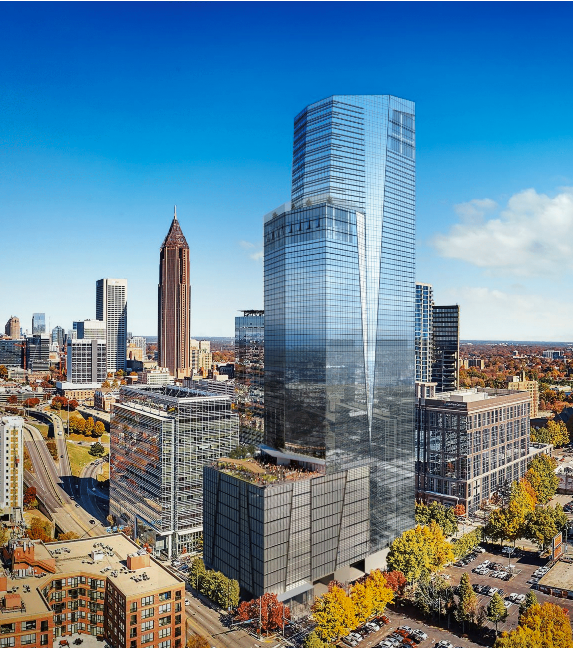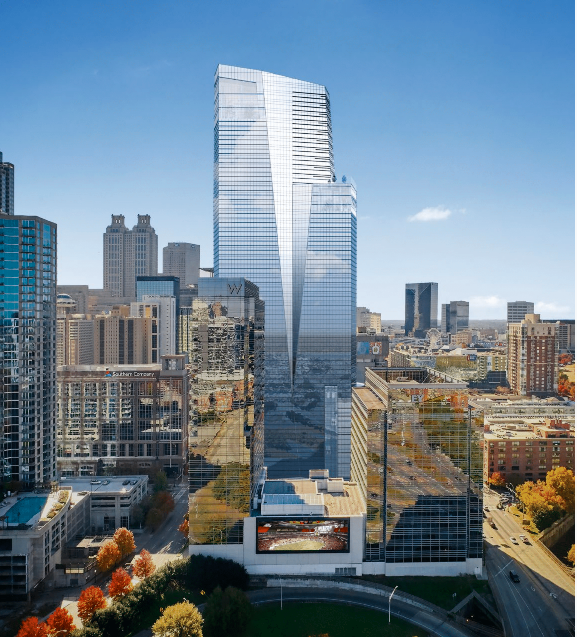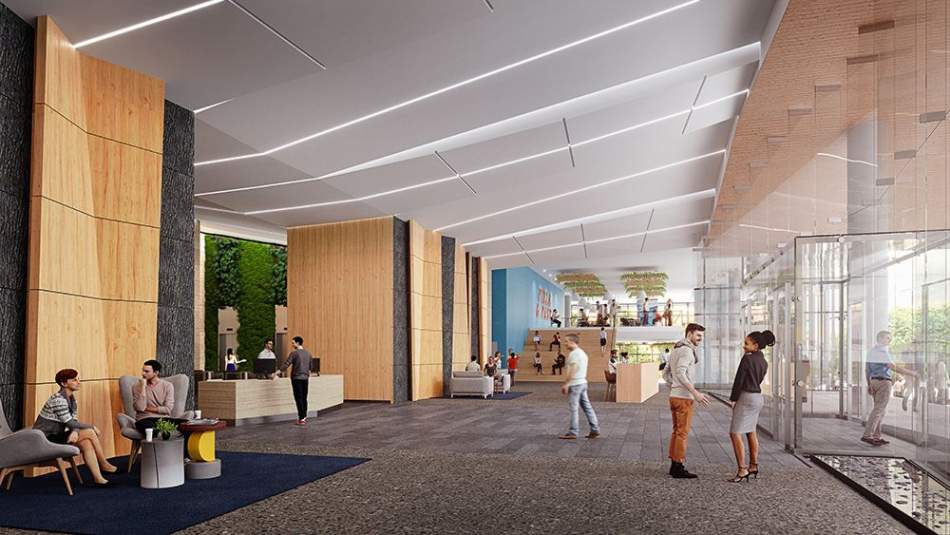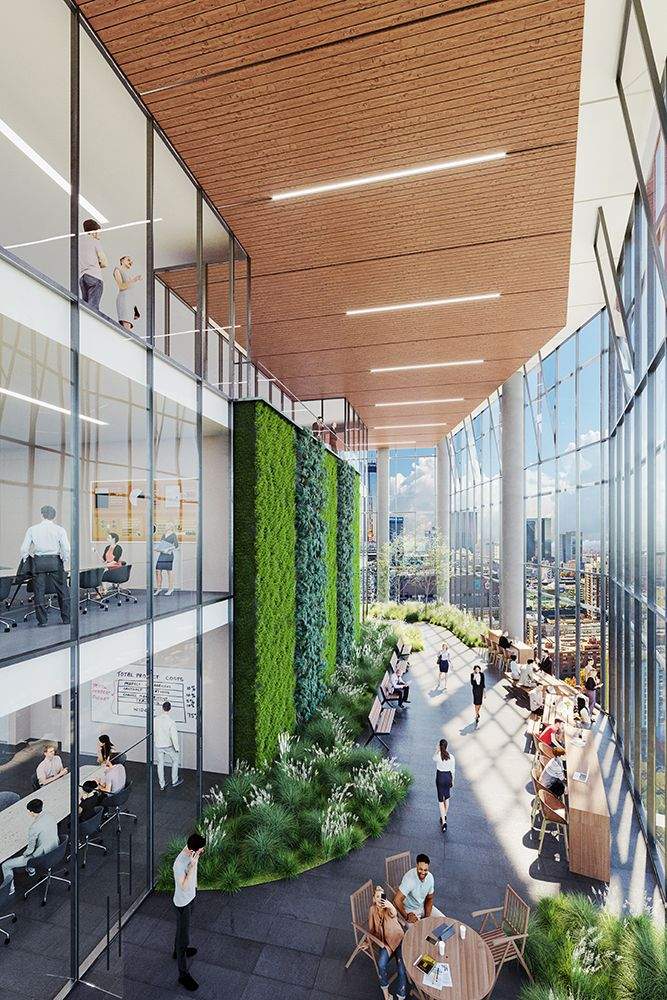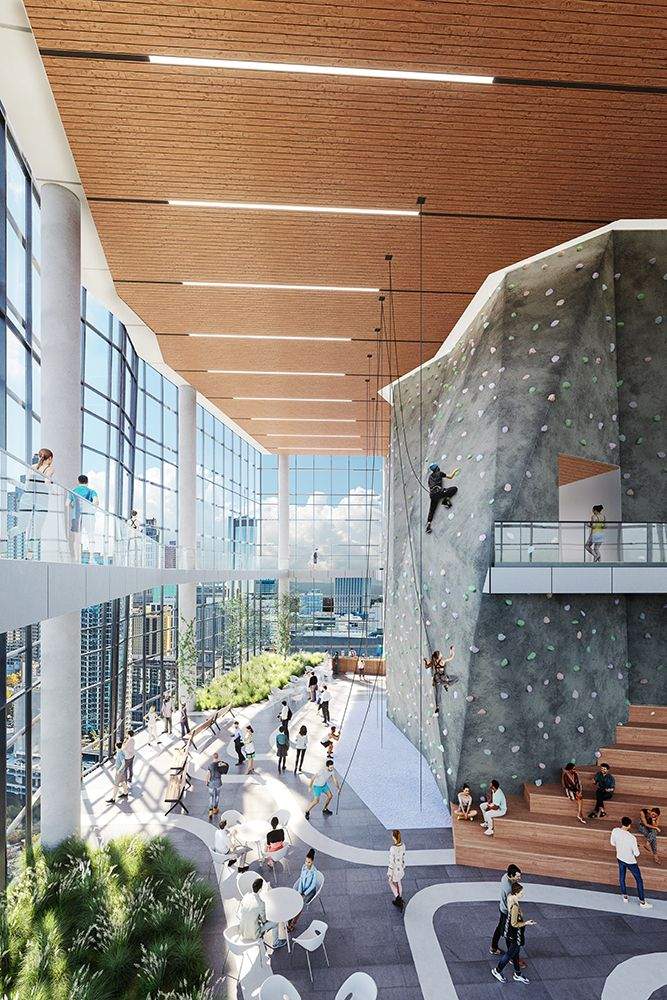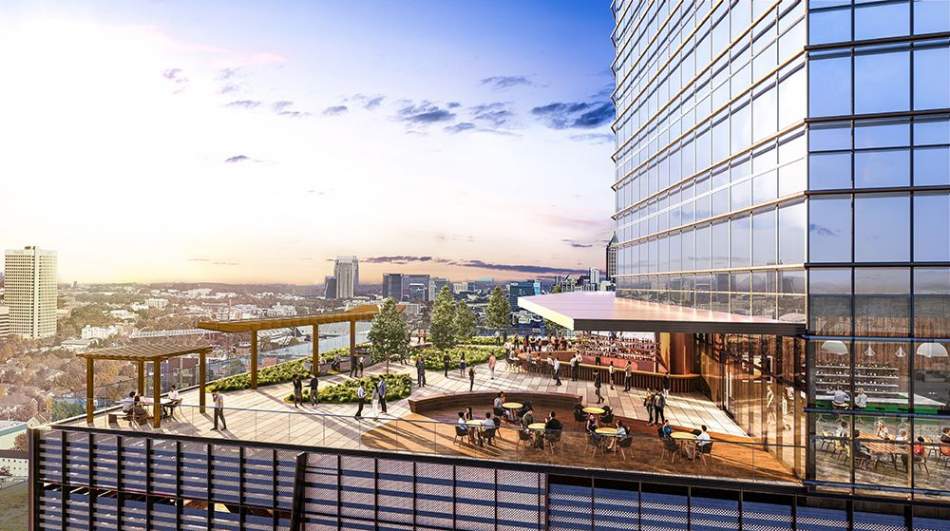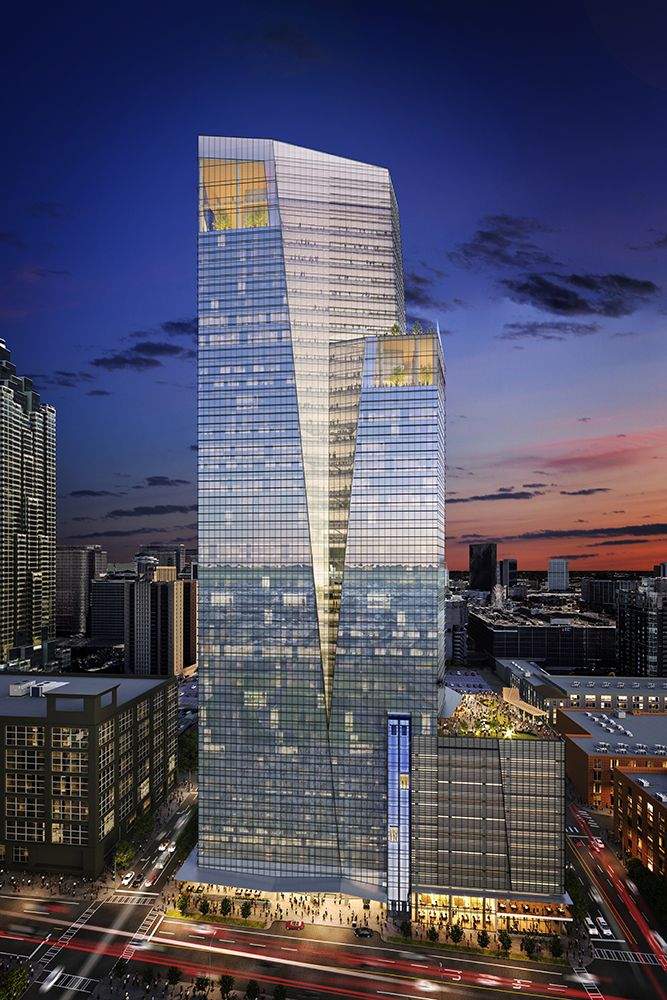At a downtown Atlanta site that’s seen no shortage of high hopes over the years but remains uninspiring asphalt parking, plans emerged in recent weeks for a structure that could redefine the intown skyline like nothing since the country’s last painful recession.
One block east of Centennial Olympic Park, overlooking the Connector like an immense futuristic shard, this latest incarnation of a skyscraper at 50 Allen Plaza hopes to capitalize on more than two dozen Fortune 1000 companies headquartered in Atlanta—and a healthy in-migration from other markets as the COVID-19 pandemic lumbers on.
Jeff Paine, a principal with Duda Paine Architects, spoke with Urbanize Atlanta this week about why the project dubbed “Fifty” remains viable right now, despite a global economic shakeup and aversion among companies to return to offices en masse. His firm counts several built Atlanta high-rises in its portfolio, including the Terminus complex in Buckhead, Cox Enterprises headquarters at Perimeter, and NRC’s global headquarters in Midtown.
Key to making it work, Paine stressed, is a rethinking of what office environments are in the future, and facets such as fresh air “stirs” on every floor. At 45 stories and 800,000 total square feet, Fifty would be no small job, but it’s a palette Paine and colleagues sound inspired to customize for an altered society, where “touchless lobbies” and extremely choreographed movements of visitors will be the norm, he believes.
Fifty is a partnership effort between Stream Realty and Australian real estate fund Drapac Capital Partners, estimated to cost $450 million. Other aspects would include 20,000 square feet of retail, 16 elevators, two parking slots for every 1,000 square feet of space, along with three “skygardens” and a possible climbing wall in the clouds. Developers announced in late December the project had entered marketing phases but would need an anchor tenant to break ground. We’ve followed up with project leaders for an update on the construction timeline and tenant signings and will post any responses here.
The following Q&A with Paine, in which he spoke candidly from his Durham, N.C. offices about the Fifty project’s challenges and Atlanta’s outlook in general, has been edited for clarity and length.
...
Urbanize Atlanta: There’s been a tower envisioned for this site, in some incarnation, for probably 15 years. But you all seem pretty confident it’s going to happen now.
Jeff Paine: Our developers are very bullish. For a building of this size, they can’t start with a tenant taking one floor, especially in this market. To move ahead they’re going to need a larger commitment. Once that happens, I think there will be a buzz, and more and more people gravitating toward it.
It’s definitely going to be a signature tower, on a signature site. As I’m headed to the airport, you drive down [interstates] 75/85, and [this site] has such a strong axial relationship right there.
With an idea of this scale right now, with the way things are, do you get funny looks from people?
No, actually. There’s two things with the Ivan Allen tower. In recent years, there hasn’t been a very tall tower proposed for Atlanta. Also in this particular part of Atlanta, it hasn’t seen a lot of development in the last decade, so I think just breaking the news, especially mid-pandemic, I think it’s noteworthy. And people have been very interested in the topics we’re addressing in this building. What’s a post-pandemic office tower look like? What are you going to have that’ll make people feel safe at work?
It’s interesting, in Austin, our first building was built back in 2004. The Frost Bank Tower, a pretty iconic tower, the tallest in Austin for a long time. When the developer launched into building that, it was the first tall building to be built in the U.S. after 9/11. If you remember that time, people were quite seriously saying they don’t think there will be tall buildings anymore. Because people will be afraid they’ll be knocked down. That certainly didn’t last.
In a way, like the skepticism now.
Back then, it was some of the same reasons for [skepticism with] Ivan Allen now. “Wow, people are going to build a tall building in a down economy? When people won’t want to get in elevators?” Even if the economy is churning again, people are talking about not coming back downtown to work. There’s markets that are going to be stronger than office in some people’s mind, but our client was bullish and saying, “No, we want to put forth the design of a post-pandemic building that addresses both real and perceived concerns.”
What are you hearing now about the prospects of people returning to the high-rise office, en masse?
It’s widespread, the range. I was talking to a developer in Dallas today. He said he’d been back in the office for several months full-time. They divided their group into—he calls them “platoons.” They have a Monday, Wednesday, Friday platoon, and a Tuesday, Thursday platoon. They’ve also said if you feel unsafe, it’s okay to work from home. I’ve heard data that says 70 to 80 percent of the people want to work from home part-time, and also [that the same percentage] want to work in the office full-time. I think there’s just a lot of conjecture out there. I do think we need to realize this is not a one-off thing. This is going to change our culture.
How?
I’ve been arguing with people for 15 years that all our entrances into office buildings should be sliding doors and not revolving or leaf doors. Maybe there’s two [sets] of them, where you walk into a vestibule and one closes behind you. Very efficient; you don’t have to touch anything. There might be some way of dispersing hypoallergenic air into this space as you’re walking through. I think people are going to be more mindful of what they touch.
I think there’s going to be a kneejerk reaction about working from home. And then an organization, like a design firm like ours, they realize their culture and collaboration really suffer if they all just sit at a computer screen in their pajama bottoms all day and try to communicate on a Zoom or Teams call. I think most people are going to realize [working from home] doesn’t allow you to have compartments to your life.
With the Atlanta tower, can you expound on this idea of a touchless lobby and elevator. First, I would get through a door without touching it, and then what would I see?
Do you know about destination dispatch elevators? You go into the elevator lobby, and instead of pushing an up or down button, there’s a station, and you push a button that might not even be on the wall, maybe on a stanchion. You’d push floor 12 in a 25-story building. Or on my iPhone, I can call the elevator.
They’re efficient because the computer system takes this signal and thinks of the fastest way to get this person to floor 12. It coordinates the movement. You get in the elevator, and there’s no buttons to push. It already knows. And there should be less people in there, because you’re going just to one floor. We have those in our NCR global headquarters in Atlanta now.
So would you need more elevators?
Probably. What we did with the Ivan Allen project, we added elevators and took the building core—the center where the elevators, stairs, and restrooms are—and split it apart so you come off the elevator, and that space on any upper floor is more of a community space. It can be used as a conference area, or for waiting for someone, a coffee bar. We wouldn’t call it a clean room, like in a lab, but it’s essentially got its own outside air coming in. More air changes than a typical office floor. After we use that area, we’d know there’s a commitment from property management to come in and clean and wipe things down.
People want to see nature, outside. All of these things make us healthier. So why not have multiple areas in an office tower that provide you the opportunity to go essentially outdoors? But it’ll be a more controlled environment protecting you from wind, with windows that open. You’d break away from your busy day in an office and essentially step outside. And at the very top of the building is the largest space, which we imagine could have a running track, a climbing wall, a real active zone.
Is there anything you foresee doing with this building that doesn’t exist in Atlanta yet?
Certainly it’s amenitized beyond what a typical developer would ever do. This larger footprint, where we’ve broken the core apart and provided conferencing on each floor, we’re seeing a move towards that in all of our office markets, where clients could not pay rent on a really nicely fitted-out conference area but share it and book it [via] their computers. Certainly these skygardens, if you will, aren’t things you see every day. I think we’re all going to have to up our game. Rents will have to accommodate these amenities.
How’s the Atlanta market faring now?
It’s funny, as I talk around the country with developer clients, they’re bullish. And they see the turnaround coming, it’s just taking time. I think Atlanta is one of the most active places for brokers today, over Dallas or other places. We’re beginning to get some traction here in the Triangle, but there seems to be a lot more activity in the Atlanta market.
You see this migration from the Northeast, where I’m from, or the Midwest and Upper Midwest, to the Southeast or Texas. I think that’s going to be a trend that continues, and I think you’ll see more companies want to relocate to the Atlanta market.
Did I read a headline somewhere that a tower just like Fifty was designed and pitched in Austin?
You reporters, I’ll tell ya’! No, when we show them side by side and include more information than was out there in the media, they’re not very similar at all. They’re both tapered office towers that are tall buildings, but they have little to nothing to do with one another.
What else about this particular building should people know?
Well, what’s the difference between a tall building and a skyscraper? A skyscraper captures people’s imaginations. And I think this can be an iconic building on the skyline that you get only so often. I think it’s going to be an exciting addition. We think a skyscraper has a responsibility to add to its context, the collective whole, and this building will be memorable.
• Downtown (Urbanize Atlanta)






